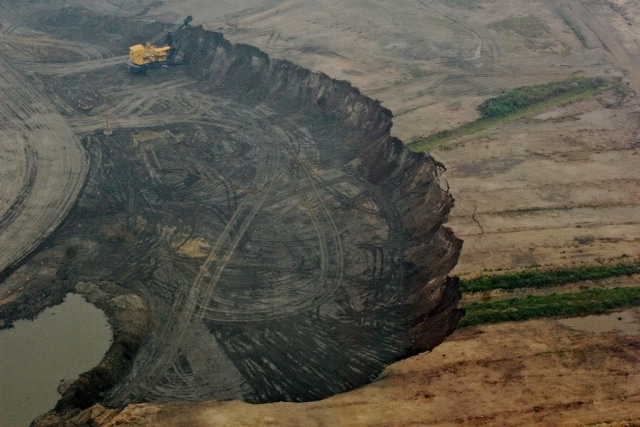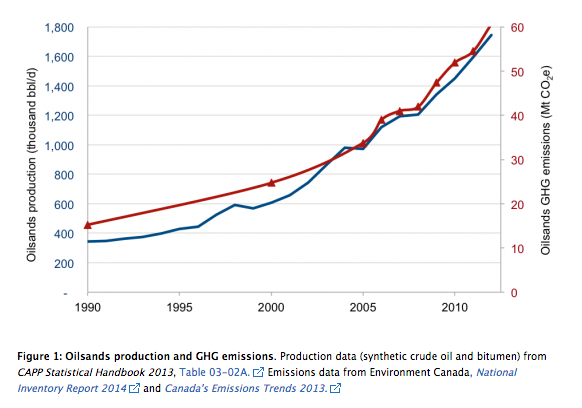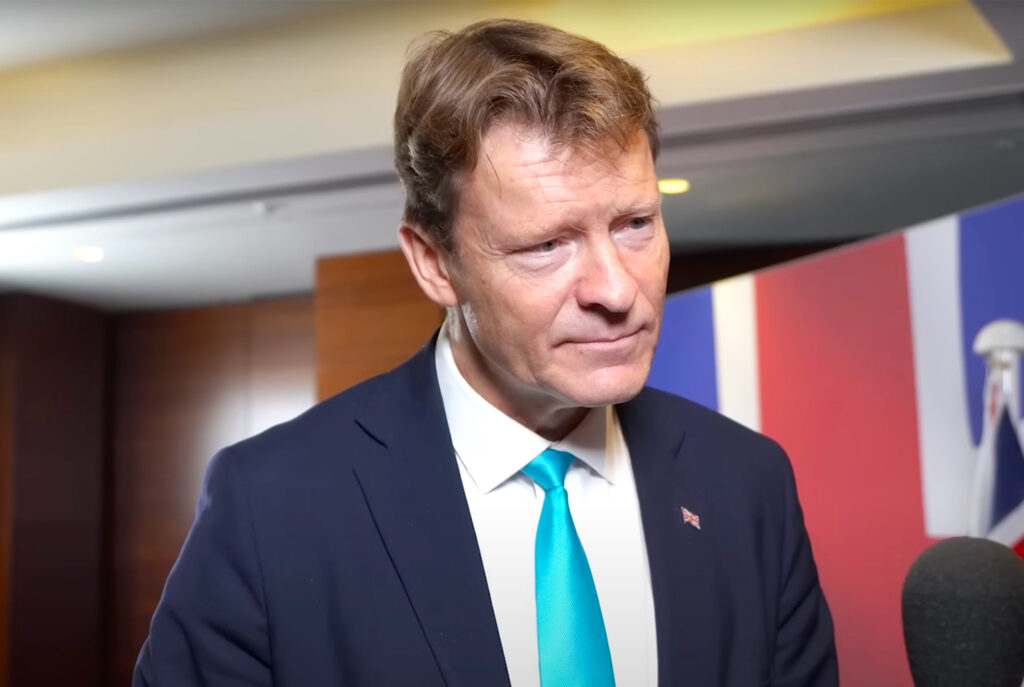Days after another delay by the Obama administration on TransCanada’s Keystone XL pipeline, members of the Alberta government are hitting the U.S. circuit to promote the oilsands and boost their “green” credentials.
Three government officials are heading to key regions in the U.S. to push for continued market access and advertise what Albertan energy minister Diana McQueen calls “our commitment to clean energy development.”
Alberta hopes to showcase investment in carbon capture and storage (CCS) technology as part of a successful emissions reduction plan.
Critics say the Alberta government’s talk about “sustainability” and “clean energy” is not in line with reality.
“If you’ve been following the Canadian government’s sales pitch for the Keystone XL pipeline, you’ve probably heard this claim before: ‘Emissions per barrel have been reduced by 26 per cent between 1990 and 2011,’” writes P.J. Partington, senior federal policy analyst with the Pembina Institute.
However, the reality, Partington writes, is that “since 1990, oilsands production has quintupled, while GHG emissions from production and upgrading have quadrupled.”
Partington writes: “[The above graph] shows the close relationship between annual GHG emissions and the rate of production — especially in recent years.”
University of Alberta energy economist Andrew Leach wrote this week that Canada’s incoherence on climate change has killed Keystone XL.
“As an antidote to our lack of ambition on policies, our governments both in Edmonton and in Ottawa have decided to work on an ambitious program of wordsmithing,” Leach wrote in Macleans.
Partington notes the oilsands sector already emits as much carbon pollution as the entire province of British Columbia, and production is projected to double within a decade. Trends in the sector’s GHG performance will therefore have a huge impact on emissions levels and major consequences for Canada.
The sales team
Cal Dallas, Alberta Minister of International and Intergovernmental Relations, is in Seattle, Wash., this week to attend the Pacific Energy Forum (April 23-25). According to the Alberta press release, Dallas will use the opportunity to drum up foreign investment interests in the oilsands and advertise extraction technologies.
“We want to work with Asian partners to better understand how to unlock their unconventional resources in an environmentally sustainable way while encouraging investment in our energy resources,” Dallas said.
“Alberta is known to be at the forefront of responsible, sustainable and innovative energy development.”
Dallas will discuss the “importance of energy trade to future economic prosperity” although it is unclear how he will address Alberta’s emissions problems, or the threat climate change poses to heavy hydrocarbon assets.
As DeSmog Canada recently reported, ExxonMobil will soon begin disclosing the risk its carbon assets face given international pressure to address climate change.
Leach recently outlined how the oilsands will quickly become unviable in the face of carbon market policies the Alberta and Canadian governments will have little control over. According to Leach’s analysis the oilsands would become uneconomic with even $50/tonne price on carbon.
According to Nicole Leonard, Canadian oil energy analyst at Bentek, oilsands production is expected to increase by 400,000 barrels a day by 2017.
Concerns are mounting, however, that Alberta’s failure to adequately address emissions output will create undue risk for potential oilsands investors.
“All leading energy system analysts agree that the oil sands, and other unconventional oils, should not be rapidly expanding,” said energy economist Mark Jaccard. International efforts are geared toward limiting global temperature increases below 2 °C.
Energy Minister Diana McQueen will also travel this week to Pittsburg, Pa., to deliver a keynote speech at the 13th annual Carbon Capture Utilization and Storage Conference (April 28-May 1) and then to New York to promote Alberta to the investment community.
David Dorward, MLA for Edmonton-Gold Bar, will be in Washington, D.C., April 27 to May 2 to meet with the Port-to-Plains Alliance, a business and government consortium representing the economic corridor from Alberta to Texas.
Dorward will work to advance the “Building Alberta Plan,” a provincial project that hopes to strengthen trade by “opening new markets for Alberta’s resources.”
CCS uncertain
At the carbon capture event, McQueen will discuss how Alberta’s two CCS projects demonstrate Alberta’s “commitment to clean energy development.”
Alberta has committed to invest $1.3 billion over 15 years in the Shell Canada Quest carbon capture project to capture waste carbon from its Scotford upgrader and the Enhance Energy Inc. Carbon Trunk Line to capture waste carbon to be used in enhanced oil recovery operations. Shell is half-way completed its project and Enhanced said it would begin constructing its carbon pipeline this spring.
Despite the two projects moving forward, Alberta originally committed to investing in four CCS projects, but two were cancelled after the companies involved deemed the return on investment insufficient.
With only two CCS operations, Alberta is expected to sequester at best three or four million tonnes of carbon a year by 2020 — just a tenth of the province’s CCS target.
“Those two CCS projects are crucial areas of research that are necessary to develop the technology and it is great that the Alberta government has taken action,” says Andrew Read, technical and policy analyst at the Pembina Institute, adding that it was “unfortunate” the investment in CCS hasn’t come with other actions to help cut greenhouse gas emissions in Alberta.
Emissions still rising rapidly
Today, emissions from the oil and gas sector are the largest source of emissions in Canada, surpassing the transportation sector, according to a recently released Environment Canada report, covering the period from 1990 to 2012.
Alberta has also worked to develop a favourable regulatory framework for future CCS projects, but new projects are unlikely without either continued massive government support or a market-altering price on carbon. To be viable, Alberta needs a price on carbon of at least $70 a tonne for CCS technology on upgraders and rising to between $120 to $160 a tonne for CCS technology to be possible for new steam-assisted oilsands operations, according to ICO2N, a Canadian industry-funded group working to advance CCS technology.
“[CCS] is one of the tools in the tool box but it is at the bottom of the toolbox,” John Bennett, executive director of the Sierra Club Canada Foundation told DeSmog Canada. “There are a thousand things that are more cost effective and useful before we [employ CCS] and as long as it is used to extract more fossil fuels, it is not a solution to the problem.”
GHG regulations?
Since 2007, Alberta has required heavy emitters to pay $15 a tonne into a technology fund if they don’t reduce the intensity of their emissions by 12 per cent from baseline levels.
“Alberta’s plan allows companies to pay a small fee to put carbon into the air and then it gives them back the money, so it is not a system that is moving investments into alternatives,” Bennett says. “Any policy that allows the net amount of carbon dioxide emissions to increase is wrong.”
This time last year, Alberta shocked the federal government and the oil industry with a plan to demand a 40 per cent reduction in per-barrel emissions and a $40 per tonne price on emissions that exceed that amount. The plan has since failed to be implemented while Ottawa announced a delay of federal oil and gas greenhouse gas regulations until they can be done “in concert with” the United States.
“The reality of the situation isn’t aligning with [the Alberta government’s] speaking points,” says Read. “I am not sure what they are reporting to decision makers [in the U.S.] because there hasn’t been any progress on developing oil and gas GHG regulations.”
The environmental movement in the United States has seized on Alberta’s environmental record in opposing the Keystone XL pipeline. The $5.4 billion pipeline is proposed to pump 830,000 barrels a day from Alberta to the U.S. Gulf Coast. Currently, the southern leg is in operation, but the approval of the northern leg crossing the border sits with the Obama administration for final approval.
After the recent delay, a final decision isn’t expected until 2015.
Image Credit: Julia Kilpatrick, Pembina Institute
Subscribe to our newsletter
Stay up to date with DeSmog news and alerts







